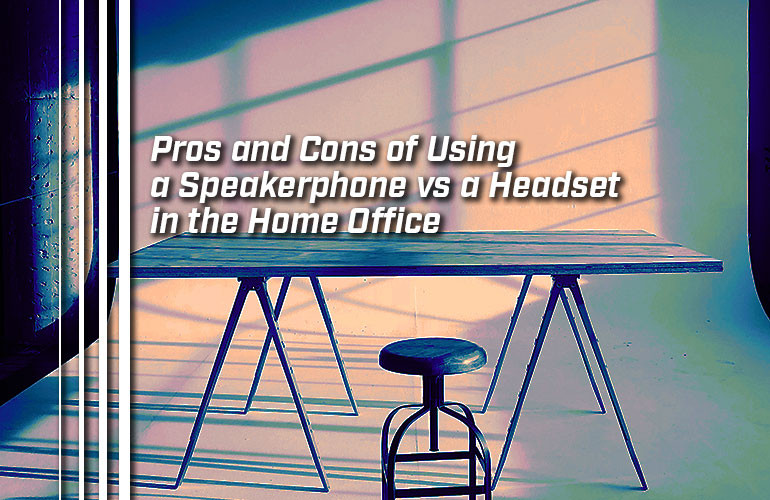For professional audio on hands-free communications when you’re working from home, there are two devices that can be your best friend: a Speakerphone and a Headset.
But which one is right for you?
In this blog, we’re going to give you the pros and cons of using a speakerphone in the home office and contrast it with the pros and cons of using a headset in the home office.
Before we start, let’s get one thing out of the way: if you want to sound professional on a call, you must upgrade from your PC’s or laptop’s built-in microphone and speakers. With a business-class speakerphone or headsets, you will sound better. Sounding better not only makes you sound more reliable and natural, but also can improve comprehension, which is the whole point of a phone call.
Let’s get into it.
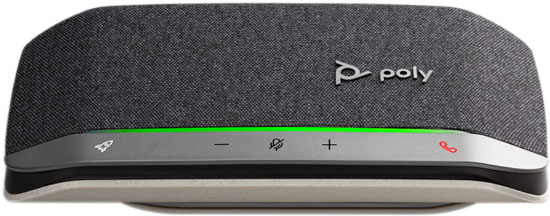
Pros: Speakerphones for the Home Office
What are the benefits of using a speakerphone in the home office with a computer? Whether you call it a speakerphone or a speaker puck, there are many reasons to go for a speakerphone.
They’re very simple to connect to your computer. They connect either via a USB cable or via Bluetooth. If you’re using USB, make sure you have the correct plug — USB-A or USB-C. If you’re using Bluetooth, you’ll need a USB Bluetooth adapter, which you plug into the computer (which has the effect of making it into a USB peripheral). Most Bluetooth speakerphones will come with a USB adapter, but make sure you have one. That’s all you need to connect.
You’ll then be able to select the speakerphone as an audio peripheral. Because USB peripherals are compatible with basically everything, speakerphones work with basically every platform, including cloud phone services.
Speakerphones don’t require you to put anything on, which for many people is preferable to having to wear something to talk. They sit on your desk, waiting for you to press the call accept button.
You’re able to hear yourself talk when using a speakerphone, unlike with a headset, especially a stereo headset. (We talk more about this issue later on.) Many people don’t like having their ears covered when they speak, because it becomes more difficult to modulate your voice properly. We’ve all heard people shouting into their phones — speakerphones avoid this problem altogether.
They’re multi-purpose devices. They work as Bluetooth or USB speakers for listening to music while you’re working and not on a call. If you’re still thinking of old, tinny speakerphones from two decades ago, you’d be amazed how great a modern speakerphone like Poly Sync 20 sounds for streaming your tunes.
Home office workers don’t always work from home. Most of them are built to be portable. For example, Jabra Speak2 40 is IP64-rated and comes with a travel pouch. If you do need to travel for work, you can have great audio quality wherever you go. And if you ever find yourself needing to have a group call with multiple people in the same room, a speakerphone gives you that versatility, too. If you’re more of a hybrid worker than a full-time home office worker, a speakerphone built for portability could be a good choice.
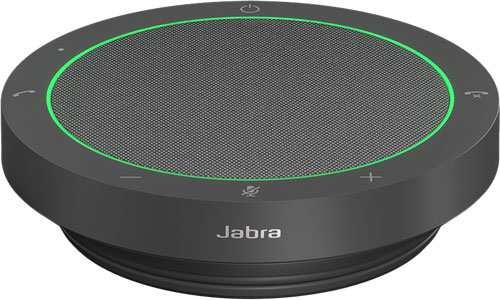
Cons: Speakerphones for the Home Office
Why would you not want to use a speakerphone? There are several reasons for preferring a headset over a speakerphone.
Speakerphones tie you to your desk. Unlike a wireless headset, which lets you be on a call while pacing, you have to be positioned close to the speakerphone to get proper audio quality. For personal use, a speakerphone’s microphone pickup range will almost certainly be good enough, but you still have to position it within a few feet of you.
Speaking of audio quality, as good as noise cancellation has gotten with speakerphones, they’re still inferior to many headsets at blocking out background noise. If you have insistent children or pets in your household, a headset is probably the better choice.
You probably don’t want to use a speakerphone with other people around — and you certainly can’t use one in a public space like a café or a shared workspace. Speakerphones aren’t private — simple as that.
The reason you can’t use them in public is because they broadcast sound openly — they’re speakers, after all. For some people, it can be more difficult to understand audio when it’s broadcast openly as compared with the focused, directed audio provided by a headset.
Speaking of headsets…
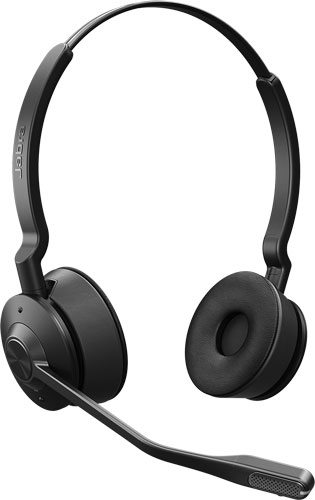
Pros: Headsets for the Home Office
What are the advantages of using a headset instead of a speakerphone in the home office?
Headsets are headphones with a microphone, typically on a boom to position the microphone closer to your mouth. By having the microphone nearer your mouth, you get a more personal sound than you would with a speakerphone.
By having the speakers covering your ears, you block out external noise and project audio directly into your ears. If, for example, you might have a child or two running around the house during work hours, this can be a big advantage. Many home office headsets feature Active Noise Cancellation (ANC), which means that the headset produces counter-sound to camouflage external noise. The effect for many people is that they’re able to understand conversations better.
Headsets are also more private than speakerphones. If you work from home and have peace and quiet during the workday, you might not care about broadcasting your conversations openly. But privacy can be important.
Wireless headsets — including Bluetooth headsets and DECT headsets — let you pace while talking, which for many people is preferable to sitting still.
Like speakerphones, many headsets are highly portable. With ANC, you’ll be able to block out the noise in a café and focus. You can even get work done in transit on a bus or subway or train. You can’t do that with a speakerphone.
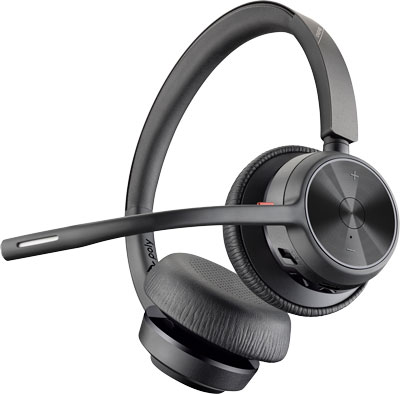
Cons: Headsets for the Home Office
Why would you not want to use a headset in the home office? There are several reasons people choose not to wear a headset.
Some people simply don’t like wearing headphones. For some people, headphones don’t work with their hair-dos. You might want to listen to music using your computer speakers, in which case you would take off your headset. When a call comes in, you need to fumble to put on the headset quickly, get the boom positioned properly, then take the call.
With a speakerphone, you don’t need to worry about this: you’re never wearing anything.
Many people don’t like having their ears covered when they talk. It can be harder to modulate your voice properly if you can’t hear yourself. A mono or single-ear headset lets you hear yourself, though some people still don’t like having one ear covered. Many headsets also support sidetone, which means that the headset immediately plays back your own voice to let you hear yourself speak. Not every headset supports this feature, though, and it doesn’t feel as natural.
Headsets also don’t work for group communications. If you do have to travel for work, you can take along your speakerphone for impromptu meetings.
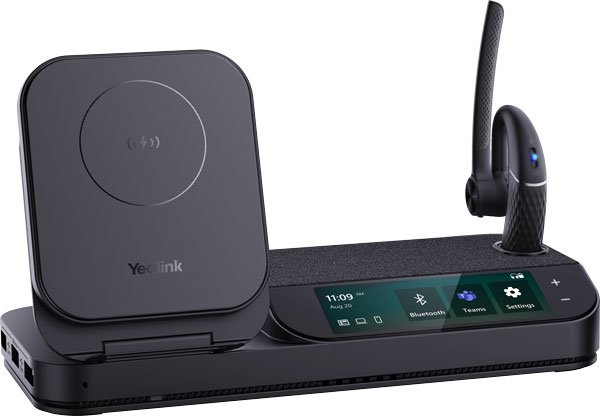
A Final Note
Is there a device that doesn’t force you to choose between a speakerphone and a headset? Yes, there are headsets whose bases have built-in speakerphones. In other words, you get a two-in-one solution.
For example, the models of Yealink BH71 with a Workstation have a base with a speakerphone in it. (It also lets you connect to multiple devices at once, is a USB hub and has a wireless charging pad!) Similarly, Yealink WH66 comes with a base station with a 4-inch touchscreen display and a speakerphone.
With devices like these, you don’t need to worry about choosing between a speakerphone and a headset — you get both!

